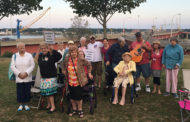
Adam Marletta
There is a darkly humorous scene in David Cronenberg’s excellent 2005 film, A History of Violence.
Viggo Mortensen‘s Tom Stall reprimands his teenage son, Jack, who has just been suspended from high school for savagely standing up to the bully who has long antagonized him, sending him to the hospital. Turns out the proverbial apple does not fall far from the tree. Unbeknownst to Jack and the rest of Tom’s family, Tom Stall is in fact Joey Cusack, a Pennsylvania mobster with a penchant for dispatching his enemies with gruesome finesse. But Tom/Joey’s recent foiling of a robbery at his small-town diner (he deftly kills both of the robbers), has risked exposing his dark past.
“In this family, we do not solve our problems by hitting people!” Tom lectures Jack.
“No,” Jack responds, “in this family, we shoot them!”
This outburst prompts Tom to slap his son.
In the wake of the seemingly unending trend of mass shootings in recent years, Cronenberg’s subversive film resonates more powerfully today than it did upon its release a decade ago.
“We have a pattern now of mass shootings in this country that has no parallel anywhere else in the world,” President Barack Obama told CBS News in an interview following the San Bernardino, CA shooting rampage (read: terrorist attack) in which 14 people were killed, last week.
This latest mass shooting follows a similar attack at a Planned Parenthood in Colorado, the murder of five Black Lives Matter activists by White Supremacists in Minnesota and the (officially designated) terrorist attacks in Paris–all within the span of three weeks. In total, 462 people have been killed and 1,314 wounded by gun violence in the U.S. this year alone.
The president is correct. The United States is unparalleled in the amount of violence–most of it carried out with guns and military-style assault weapons–its citizens routinely engage in. This violence, contrary to popular contention, is not aberrational or part of some recent trend. It is not, as my family relatives frequently lament, a result of the world “becoming more dangerous.”
No, this violence is deeply imbedded in our history and culture. It is as American as apple pie and baseball. As Allen Ginsberg wrote, “America, why are your libraries full of tears?”
It is not that America has become a more dangerous place. The nation has been a dangerous place since its founding.
American history–which began with the mass genocide of the Native Americans–has been colored by slavery, the Civil War, Jim Crow, and the continuous oppression of the poor, women, gays, people of color and communists, as well as the complete disenfranchisement of people with disabilities.
Furthermore, the U.S. had the bloodiest labor battles in the industrialized world. The few remedies we have attained to the draconian capitalist workplace (the eight-hour workday, weekends off, child labor laws, etc.) came about through long, difficult mass struggle wherein labor activists were physically beaten or shot.
“Nations are not communities and never have been,” Howard Zinn wrote in the opening chapter to A People’s History of the United States. “The history of any country, presented as the history of a family, conceals fierce conflicts of interest… between conquerors and conquered, masters and slaves, capitalists and workers, dominators and dominated in race and sex.”
A 2007 Small Arms Survey found that America has the highest rate of gun ownership in the world–about 89 per 100 people. There are nearly 310 million firearms in the U.S. in total. And, as with defense contractors in the wake of the Paris attacks, gun retailers are seeing surging sales following the shooting in San Bernardino.
“Behind closed doors, speaking with investors and Wall Street analysts,” investigative journalist, Lee Fang writes in The Intercept, “the gun industry views mass shootings as an opportunity to make lots of money.”
All you gun-nuts feel stupid, yet?
Since America’s founding, the state has relied on right-wing militias to spread fear and racism and crack down on union leaders, activists, socialists, and anyone else the state deems a threat. Groups like the Ku Klux Klan, the White League, and the American Legion (which was originally a right-wing, pro-war group that attacked anti-war protesters) operate with, in the words of Chris Hedges, “the state’s tacit if unofficial blessing.” They are the government’s “useful idiots.” And they are a prime example of capitalism pitting one segment of the working class against the other.
This brand of vigilante violence is “deeply ingrained in the American psyche,” Hedges writes in his recent book, Wages of Rebellion. “They are mostly white men who prey on people of color and radicals,” he writes. “They are capitalism’s ideological vanguard, its shock troops used to break populist movements and tyrannize the oppressed.”
And let’s get one thing straight: It is this racism–the irrational fear of “The Other”–that fuels the right’s love of guns. Gun-ownership among conservatives has nothing to do with fear of the government, or protecting oneself in one’s home. (If the U.S. military were to descend upon one of these gun-nuts’ homes, his AK-47 would prove a pitifully useless form of “defense.”) It has everything to do with fear of black people and the “radicals who champion the cause of the oppressed,” as Hedges writes.
Indeed, the South Park-inspired cartoon, “A Brief History of the United States of America,” featured in Michael Moore’s 2002 documentary film, Bowling for Columbine hits the nail right on the head.
These gun-loving right-wingers idealize the concept of the lone vigilante fighter who takes the law into his own hands–figures like Clint Eastwood in the Dirty Harry movies. They claim to hate and distrust the government, yet revere the military–as if the Pentagon is somehow not a part of the government. They drive gas-guzzling SUVs emblazoned with the ubiquitous “Don’t Tread on Me,” serpent bumper-sticker, seemingly oblivious to the fact that they are driving on publicly-funded roads and highways. They fervently defend the Second Amendment (which, as liberal television host, Thom Hartmann points out, was originally designed to preserve slavery), yet sit idly by as the First and Fourth Amendments are shredded right in front of us.
And these anti-intellectual zealots are no longer some fringe section of the far-right. They now control half of the U.S. Congress.
The right childishly argues that “guns do not kill people–people kill people.” Perhaps there is, strictly speaking, some truth to this.
But, as Kurt Vonnegut wryly observed in his semi-autobiographical novel, Timequake, “That there are such devices as firearms, as easy to operate as cigarette lighters and as cheap as toasters, capable at anybody’s whim of killing Father or Fats or Abraham Lincoln or John Lennon or Martin Luther King, Jr., or a woman pushing a baby carriage, should be proof enough for anybody that being alive is a crock of shit.”






A History of Violence
Adam Marletta
There is a darkly humorous scene in David Cronenberg’s excellent 2005 film, A History of Violence.
Viggo Mortensen‘s Tom Stall reprimands his teenage son, Jack, who has just been suspended from high school for savagely standing up to the bully who has long antagonized him, sending him to the hospital. Turns out the proverbial apple does not fall far from the tree. Unbeknownst to Jack and the rest of Tom’s family, Tom Stall is in fact Joey Cusack, a Pennsylvania mobster with a penchant for dispatching his enemies with gruesome finesse. But Tom/Joey’s recent foiling of a robbery at his small-town diner (he deftly kills both of the robbers), has risked exposing his dark past.
“In this family, we do not solve our problems by hitting people!” Tom lectures Jack.
“No,” Jack responds, “in this family, we shoot them!”
This outburst prompts Tom to slap his son.
In the wake of the seemingly unending trend of mass shootings in recent years, Cronenberg’s subversive film resonates more powerfully today than it did upon its release a decade ago.
“We have a pattern now of mass shootings in this country that has no parallel anywhere else in the world,” President Barack Obama told CBS News in an interview following the San Bernardino, CA shooting rampage (read: terrorist attack) in which 14 people were killed, last week.
This latest mass shooting follows a similar attack at a Planned Parenthood in Colorado, the murder of five Black Lives Matter activists by White Supremacists in Minnesota and the (officially designated) terrorist attacks in Paris–all within the span of three weeks. In total, 462 people have been killed and 1,314 wounded by gun violence in the U.S. this year alone.
The president is correct. The United States is unparalleled in the amount of violence–most of it carried out with guns and military-style assault weapons–its citizens routinely engage in. This violence, contrary to popular contention, is not aberrational or part of some recent trend. It is not, as my family relatives frequently lament, a result of the world “becoming more dangerous.”
No, this violence is deeply imbedded in our history and culture. It is as American as apple pie and baseball. As Allen Ginsberg wrote, “America, why are your libraries full of tears?”
It is not that America has become a more dangerous place. The nation has been a dangerous place since its founding.
American history–which began with the mass genocide of the Native Americans–has been colored by slavery, the Civil War, Jim Crow, and the continuous oppression of the poor, women, gays, people of color and communists, as well as the complete disenfranchisement of people with disabilities.
Furthermore, the U.S. had the bloodiest labor battles in the industrialized world. The few remedies we have attained to the draconian capitalist workplace (the eight-hour workday, weekends off, child labor laws, etc.) came about through long, difficult mass struggle wherein labor activists were physically beaten or shot.
“Nations are not communities and never have been,” Howard Zinn wrote in the opening chapter to A People’s History of the United States. “The history of any country, presented as the history of a family, conceals fierce conflicts of interest… between conquerors and conquered, masters and slaves, capitalists and workers, dominators and dominated in race and sex.”
A 2007 Small Arms Survey found that America has the highest rate of gun ownership in the world–about 89 per 100 people. There are nearly 310 million firearms in the U.S. in total. And, as with defense contractors in the wake of the Paris attacks, gun retailers are seeing surging sales following the shooting in San Bernardino.
“Behind closed doors, speaking with investors and Wall Street analysts,” investigative journalist, Lee Fang writes in The Intercept, “the gun industry views mass shootings as an opportunity to make lots of money.”
All you gun-nuts feel stupid, yet?
Since America’s founding, the state has relied on right-wing militias to spread fear and racism and crack down on union leaders, activists, socialists, and anyone else the state deems a threat. Groups like the Ku Klux Klan, the White League, and the American Legion (which was originally a right-wing, pro-war group that attacked anti-war protesters) operate with, in the words of Chris Hedges, “the state’s tacit if unofficial blessing.” They are the government’s “useful idiots.” And they are a prime example of capitalism pitting one segment of the working class against the other.
This brand of vigilante violence is “deeply ingrained in the American psyche,” Hedges writes in his recent book, Wages of Rebellion. “They are mostly white men who prey on people of color and radicals,” he writes. “They are capitalism’s ideological vanguard, its shock troops used to break populist movements and tyrannize the oppressed.”
And let’s get one thing straight: It is this racism–the irrational fear of “The Other”–that fuels the right’s love of guns. Gun-ownership among conservatives has nothing to do with fear of the government, or protecting oneself in one’s home. (If the U.S. military were to descend upon one of these gun-nuts’ homes, his AK-47 would prove a pitifully useless form of “defense.”) It has everything to do with fear of black people and the “radicals who champion the cause of the oppressed,” as Hedges writes.
Indeed, the South Park-inspired cartoon, “A Brief History of the United States of America,” featured in Michael Moore’s 2002 documentary film, Bowling for Columbine hits the nail right on the head.
These gun-loving right-wingers idealize the concept of the lone vigilante fighter who takes the law into his own hands–figures like Clint Eastwood in the Dirty Harry movies. They claim to hate and distrust the government, yet revere the military–as if the Pentagon is somehow not a part of the government. They drive gas-guzzling SUVs emblazoned with the ubiquitous “Don’t Tread on Me,” serpent bumper-sticker, seemingly oblivious to the fact that they are driving on publicly-funded roads and highways. They fervently defend the Second Amendment (which, as liberal television host, Thom Hartmann points out, was originally designed to preserve slavery), yet sit idly by as the First and Fourth Amendments are shredded right in front of us.
And these anti-intellectual zealots are no longer some fringe section of the far-right. They now control half of the U.S. Congress.
The right childishly argues that “guns do not kill people–people kill people.” Perhaps there is, strictly speaking, some truth to this.
But, as Kurt Vonnegut wryly observed in his semi-autobiographical novel, Timequake, “That there are such devices as firearms, as easy to operate as cigarette lighters and as cheap as toasters, capable at anybody’s whim of killing Father or Fats or Abraham Lincoln or John Lennon or Martin Luther King, Jr., or a woman pushing a baby carriage, should be proof enough for anybody that being alive is a crock of shit.”